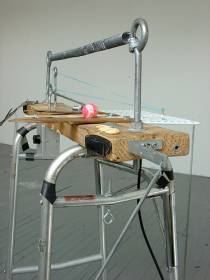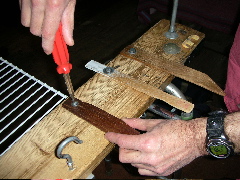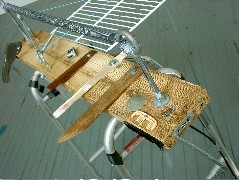



Live at The Tank, Manhattan
Jack Wright (saxophone), Andrew Drury (percussion), Anna Friz
(accordian, harmonica, electronics), Eric Leonardson (springboard).
Recorded live by free103point9 on
Thursday, May 31, 2007. Duration 16:42
Aside from an interest in the sonic potential
of coil springs, I began with no preconceived idea of how the
Springboard should sound or look. Initially, I did not aim to make a
musical instrument. I knew springs had been used in early artificial
reverb effects, and I was simply intrigued by the sounds of retracting
springs for screen doors and garage doors, and I was intent on using
readily available materials.
 What developed is a device that amplifies a
variety common objects and materials. The Springboard not only generates
a wide range of "strange sounds," it has become an extremely flexible
and unique instrument. The following text and photos describe the
Springboard’s construction and its various sounds. What developed is a device that amplifies a
variety common objects and materials. The Springboard not only generates
a wide range of "strange sounds," it has become an extremely flexible
and unique instrument. The following text and photos describe the
Springboard’s construction and its various sounds.
 Attached across the top of an aluminum walker is a
2" x 6" board. A single piezo
disk contact microphone is mounted inside a small cavity in the
underside of board. By extension, the high sensivity of the piezo pickup
enables the entire board amplify anything attached, hence it is
transformed into a receiving surface for amplification of any number of
vibrating objects I choose. Among them: Attached across the top of an aluminum walker is a
2" x 6" board. A single piezo
disk contact microphone is mounted inside a small cavity in the
underside of board. By extension, the high sensivity of the piezo pickup
enables the entire board amplify anything attached, hence it is
transformed into a receiving surface for amplification of any number of
vibrating objects I choose. Among them:
- coil springs of various sizes
- combs
- tuned wood slats (ala Hans Reichel’s Daxophone)
- small metal grill
- large rubber bands
... all of which are
bowed, plucked, rubbed or struck with brushes, chopsticks, friction
mallets, or my bare fingers. With higher amplification the entire
instrument is sensitive enough to pick up sounds of the room itself. I
also amplify objects placed directly on it, such as a music box
mechanism, large rubber bands, a vibrating massager, and a small piezo
disk speaker connected to the earphone jack of a pocket radio.
 The sound that coil springs make have a lot of
inharmonic content. In other words, instead of a single clearly pitched
tone it produces a group or agglomeration of pitches that are not
harmonically related, such as a bell. (To some listeners it is a "cold"
or "haunting" tone. At times the tone may even suggest an unpleasant
"industrial" sound. Of course, these interpretaions are subjective.) The sound that coil springs make have a lot of
inharmonic content. In other words, instead of a single clearly pitched
tone it produces a group or agglomeration of pitches that are not
harmonically related, such as a bell. (To some listeners it is a "cold"
or "haunting" tone. At times the tone may even suggest an unpleasant
"industrial" sound. Of course, these interpretaions are subjective.)
Several coil
springs are used on the Springbaord. I have one spring attached to each
leg of the walker with the other end of each coil spring attached to
different points on the board. Usually I bow the springs, as well as the
wooden slats. If you haven’t heard Hans Reichel’s daxophone performances or
recordings you might associate the sounds of the wooden slats with
murmuring, whining, cajoling, snoring, and growling voices or animal
sounds. They can be comic and disturbing. I bend the pitch of my crude
daxophones by applying pressure with my non-bowing hand. The results
work well with saxophone players and the extended vocal techniques of
Carol Genetti, a frequent collaborator of mine.
My techniques
for playing the Springboard continue to develop through practice. As a
drummer I have learned how to become sensitive to material response of
the Springboard. I seldom ever hit any parts of the instrument as one
hits a drum. Instead, bows, brushes, friction mallets, chopsticks, my
bare hands and fingers apply controlled pressure, flexion, and friction
to produce its most intriguing sounds. As I mentioned, I prefer using a
cello bow on coil springs rather than a plucking or striking them. As
with a stringed instrument, bowing produces a harmonically richer tone
than plucking a string. The same applies for bowed coil springs.
With large rubber
bands stretched around the eyebolts and grill, I make sounds that are
identical in range and timbre to an acoustic bass. I pluck them or use
chopsticks to drum on them.

In 1999 I
began using an Oberheim Echoplex Digital Pro to sample, loop, and
overdub sounds in real-time for my performances, both solo and with the
Plasticene theater company. However, in free improvised ensemble
performances I prefer to use the Springboard without the Echoplex. In
these situations the musical flow will shift, halt, or reverse
directions faster than I can respond to them with the Echoplex .

A key inspiration for
making my own instruments came from Hal Rammel, who began teaching instrument invention
workshops at the Experimental
Sound Studio in 1990. I had also seen and heard Nicolas Collins and
Elliot Sharp perform on invented instruments of varying complexity, in
concerts co-sponsored by ESS and Randolph Street Gallery in the
late-80s. And prior to that I attended percussion recitals as an art
student at Northern Illinois University, where it wasn't unusual to see
musicians playing hubcaps, bowls, and other everyday non-musical items.
Prior the
invention of the Springboard I had been using drums, an analog
synthesizer, a 4-track cassette recorder, reel-to-reel tapes, prepared
bass guitar, MIDI controlled samplers, drum machine, computer
sequencing, turntables, and environmental (or concrete) sounds as my
instruments and/or materials. In the studio I would connect these
devices in somewhat complex routing schemes to create recorded pieces.
In that environment I was able to use my studio as an instrument itself.
I still use some of these devices and techniques in my performances and
studio compositions.
| 